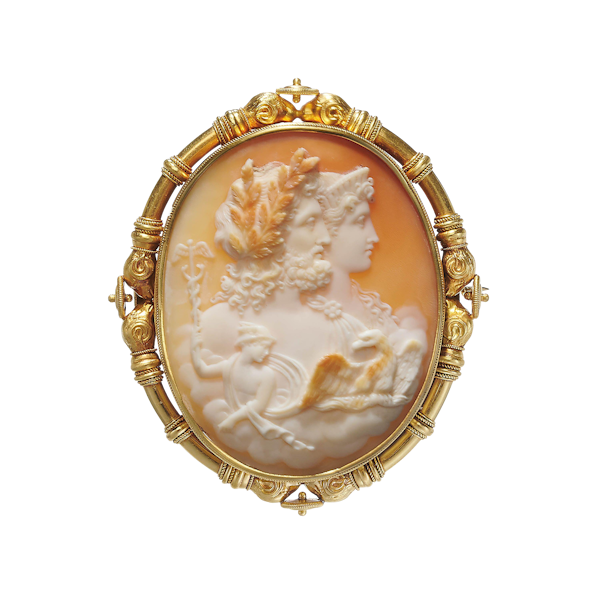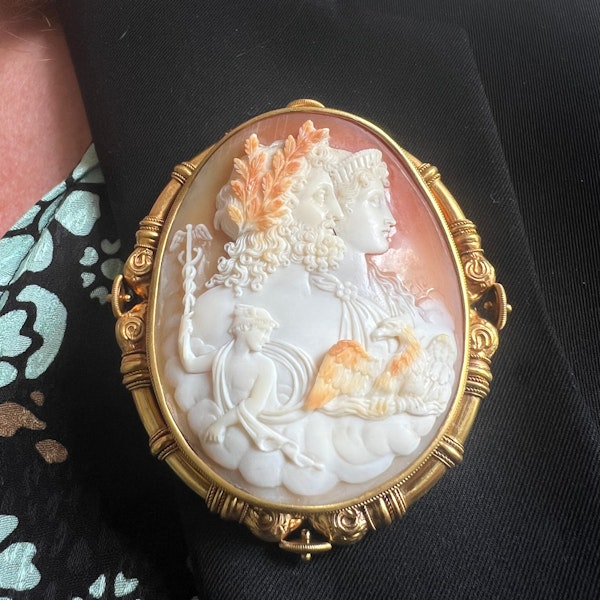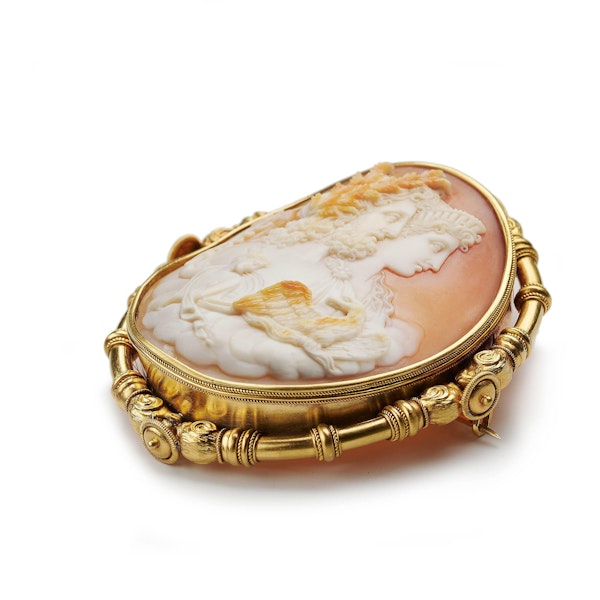Antique Shell Cameo And Gold Brooch, Jupiter, Juno And Mercury, Circa 1875
Antique Shell Cameo And Gold Brooch, Jupiter, Juno And Mercury, Circa 1875
£8,000.00
Description
An antique shell cameo and gold brooch, featuring a conch shell cameo, carved with figures representing the Roman god Jupiter or the Greek god Zeus, with his eagle symbol and the Roman goddess Juno or the Greek goddess Hera, with a smaller carving of Mercury or Hermes, holding a caduceus, on clouds, set in a gold frame, with double ram's heads at each quarter and Etruscan style wire work, with a Vatican mark and CIIIP maker's mark, circa 1875. The cameo has a signature, which could be for Otto.
Jupiter was the chief deity of the Roman state religion, he was the god of the sky and thunder and king of the gods in their religion and mythology. He was represented holding a thunderbolt and his primary sacred animal was the eagle. These two emblems were often combined to represent the god in the form of an eagle holding a thunderbolt in its claws, this emblem was often seen on Roman coins. He was a divine witness to oaths, the sacred trust on which justice and good government depend. Many of his functions were focussed at the Citadel, on the Capitoline Hill. In the Capitoline Triad he was the central guardian of the state, with Juno and Minerva. His sacred tree was the oak. The Romans regarded Jupiter as the equivalent of the Greek god Zeus.
Juno was a goddess of the ancient Roman religion. Among her roles was the protector and special counsellor of the state, a goddess of love and marriage, she was also said to watch over the women of Rome. Her sacred animal was the peacock. She was often shown wearing a diadem. She was a daughter of Saturn, the sister and wife of Jupiter and the mother of Mars, Vulcan, Bellona and Juventas. She was equated to the Greek goddess Hera.
Mercury was a major god in Roman religion and mythology. He was the god of financial gain, commerce, eloquence, messages, communication, divination, travellers, boundaries, luck, trickery and thieves also serving as the guide of souls to the underworld. He was considered to be either the son of either Maia and Jupiter or of Caelus and Dies. He is often depicted holding the caduceus in his left hand. Similar to his Greek counterpart, Hermes, He was awarded a magic wand, by Apollo, which later turned into the caduceus, the staff with intertwined snakes. He was often represented wearing a winged hat.
With thanks to Robert Littman - classics professor and Wikipedia.
Approximate Weight: 37.32 grams
| item details | |
|---|---|
| Origin | Italian |
| Period | Pre 1900 |
| Style | Victorian |
| Condition | Very good |
| Materials | Gold |
| Dimensions | Length 69.2mm, width 60mm |
Product REF: S4623B








